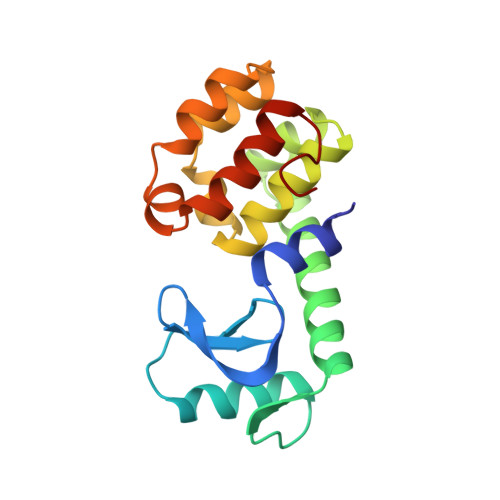Similar hydrophobic replacements of Leu99 and Phe153 within the core of T4 lysozyme have different structural and thermodynamic consequences.
Eriksson, A.E., Baase, W.A., Matthews, B.W.(1993) J Mol Biol 229: 747-769
- PubMed: 8433369
- DOI: https://doi.org/10.1006/jmbi.1993.1077
- Primary Citation of Related Structures:
1L85, 1L86, 1L87, 1L88, 1L89, 1L90, 1L91, 1L92, 1L93, 1L94, 1L95 - PubMed Abstract:
Two bulky amino acids within the core of phage T4 lysozyme have each been replaced in turn with a series of hydrophobic amino acids. In one set of experiments, Leu99 was replaced with Phe, Met, Ile, Val and Ala. In the second series, Phe153 was replaced with Leu, Met, Ile, Val and Ala. The double mutant in which both Leu99 and Phe153 were replaced with alanine was also constructed. The change in stability of the protein associated with each substitution and the crystal structure of each variant have been determined. In the case of replacements at position 99 the protein behaves in a relatively rigid manner, and changes very little in response to substitutions. In contrast, the protein is more flexible and adjusts much more in response to substitutions of Phe153. In both cases there is a roughly linear dependence between the stability of the mutant protein relative to wild-type (delta delta G) and the difference in the hydrophobic strength of the amino acids involved in the substitution based on solvent transfer measurements (delta delta Gtr). The change in delta delta G is, however, much greater than delta delta Gtr. For the Phe153 replacements the discrepancy is about 1.9-fold, while for the Leu99 series it is about 2.6-fold. Mutants such as Leu99-->Ala, for which the protein remains essentially rigid, tend to create larger cavities and so incur a larger energy of destabilization. Mutants such as Phe153-->Ala, for which the protein structure tends to relax, result in smaller cavities and so are less destabilized. Mutants L99I and L99V are less stable than expected from considerations of transfer free energy and cavity formation due to introduced strain caused by the replacement of Leu99 with a residue of different shape. Mutant F153L is more stable than the reference wild-type, even though the transfer free energy of Leu is less than that of Phe. The increase in stability is apparently due to torsional strain in the side-chain of Phe153 that is present in wild-type lysozyme, but is relieved in the mutant structure.
Organizational Affiliation:
Institute of Molecular Biology, Howard Hughes Medical Institute, Eugene, OR.
















